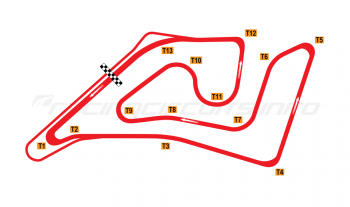Cascavel
Circuit Overview
The Autódromo Zilmar Beux at at Cascavel is one of a handful of circuits which appeared in Brazil in the early 1970s, capitalising on the popularity of motorsport generated by the exploits of a new generation of star drivers.
A lack of investment hampered progress in recent years until the circuit was given a new lease of life after being taken into public ownership and extensively refurbished.
The circuit today hosts a catalogue of local racing.
Circuit History
The circuit's story begins in 1964, when a bunch of amateur drivers and enthusiasts organised a test event on the streets of the city. These pioneering characters, led by Zilmar Beux, formed a corporation with the aim of creating a permanent circuit. By 1970, they had raised enough funding to buy a parcel of land on the south eastern outskirts of the city and set about creating their vision.
A course, designed by Beux, was carved out of the rich clay soil and began operating that year, with the races proving very popular. Estimates suggest the attendance at the first race was around 20,000 - not bad considering the population of the city at that time was around 90,000! Within short order, the course became a hub for motorsport in the region.
What's in a name?
Cascavel means 'rattlesnake' in Portuguese, meaning the circuit is effectively the 'Rattlesnake Raceway'.
Disaster nearly struck in 1973, when the Paranaense Automobile Federation decided to ban dirt track racing, citing safety concerns. Beux and his supporters were not deterred, however, and set about paving the circuit. Despite the success of the early dirt events, funds were not sufficient for such an expensive exercise and so new shareholdings were sold in the facility to raise the necessary capital. In just 38 days, the autodrome duly become the first circuit in Paraná state with a sealed asphalt surface. The city's mayor, Octacillio Mionn played a major role in the resurfacing, donating much of the gravel used in the base layers from the left-overs of the city's own paving works.
Sadly, the opening event on April 24, 1973, was to bring an end to Beux's active association with the track. So consumed had he been with the track constrution, Beux did not have time to prepare a car for himself for the races and so had to stand on the sidelines as his vision sprang to life. One of the competitors on the opening weeking was the new mayor of Cascavel, Pedro Muffato, who was an accomplished racer. The media seized upon the storyline of the racing mayor, completely overshadowing Beux's own contribution to the circuit and in some cases reporting that it was in fact Muffato who had presided over the circuit's paving. In disgust, Beux turned away from motorsport altogether and did not return to the track he had founded for another 30 years.
Despite the loss of Beux's guiding hand, a diverse calendar of racing was soon established, with the track quickly becoming one of the four main circuits of Brazil. In 1987 one of its signature events was born, when the track hosted an exhibition truck race to test the safety of the concept. Tragically, a fatal accident during the event claimed the life of track president Jeferson Ribeiro da Fonseca, who was been competing in the race. It was not until 1996 that Formula Truck was reborn, with Cascavel one of the founding circuits.
Brazil's other major series, the wildly popular Stock Cars, paid a visit in 2001, for which a chicane was inserted ahead of the plunging downhill Bacião corner but the following years saw a steady decline in competition as the lack of investment began to show. The major series then moved elsewhere, leaving Cascavel to busy itself with minor championships, local races and general testing.
After 41 years of operating the facility, the Automobile Club of Cascavel — by then chaired by Zilmar's son, Migeul Beux — donated the track to city authorities, bringing into public ownership for the first time. The city government began an extensive remodelling project in 2012, with the entire circuit widened and resurfaced, run-off areas improved and FIA standard kerbing installed. The start/finish was relocated to the former back straight in order to provide a larger paddock area, 36 pit garages and a helipad. Facilities for spectators were also greatly enhanced, with new access tunnels, concessions areas and a restaurant.
In a fitting tribute, the facility was renamed Autódromo Internacional Zilmar Beux in honour of its chief architect and reopened in August 2012 with a round of Formula Truck, witnessed by an impressive 50,000 spectators. The circuit also regained its position on the Stock Car Brasil calendar in September 2012 and went on to host round of the Moto GP1000 superbike championship.
Recent years, however, have seen the trucks and stock car racers move on elsewhere, leaving Cascavel with a calendar of mainly local racing.
Jump onboard
Circuit info
- Autódromo Internacional Zilmar Beux, Cascavel, Paraná, Brazil
Rate This Circuit
Votes: 4582
Plan a visit
Get your race tickets!
Brought to you with: 
We've teamed up with Motorsports Tickets to bring you the best deals for Formula One, MotoGP, Le Mans and more.













